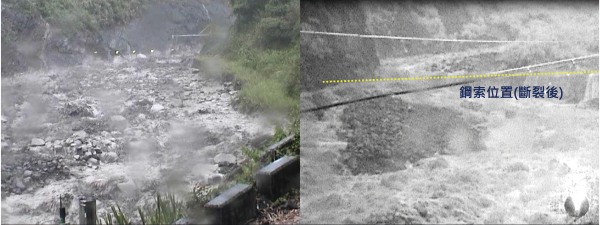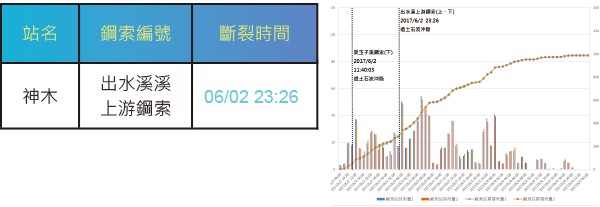建置緣由Background and Purpose
民國88年921地震及90至91年間桃芝、納莉颱風重創中南部,導致地質鬆動、土石流風險升高。為強化監測,
- 民國91年建置白布帆、九份二山、神木、上安、郡坑及豐丘等6座固定式觀測示範站。
- 民國92年增設大粗坑、鳳義坑、射馬干及華山4站。
- 民國93年完成豐山、大興、松鶴3站,三年間共建置13座觀測站。
- 民國97年建置坪頂崩塌觀測站,於雲林縣林內鄉坪頂村進行邊坡變形觀測。
- 民國98年莫拉克颱風重創南台灣後,於99年增設羌黃坑、集來、來義、大鳥4站。
- 民國100年完成南豐站。
- 民國102年蘇拉颱風後建置和中站。
- 民國106年進行火炎山與寒溪站土石流觀測站儀器調整作業。
Following the devastating effects of the 1999 Chi-Chi Earthquake and the impact of Typhoons Toraji (2001) and Nari (2001) on central and southern Taiwan, which resulted in loosened geological structures and increased the debris flow risks, efforts were made to enhance monitoring capabilities.
- In 2002, six debris flow monitoring stations were established at Baibufan, Jiufen-ershan, Shenmu, Shang-an, Junkeng, and Fongciou.
- In 2003, four additional stations were set up at Dacukeng, Fongyikeng, Shemagan, and Huashan — totaling 13 stations constructed over three years.
- In 2004, three more stations were completed at Fongshan, Dasing, and Songhe.
- In 2008, the Pingding Landslide Monitoring Station was built in Pingding Village, Linnei Township, Yunlin County to observe slope deformations.
- After Typhoon Morakot severely affected southern Taiwan in 2009, four more stations were added in 2010 at Qianghuangkeng, Jilai, Laiyi, and Daniao.
- The Nanfeng Station was completed in 2011.
- Following Typhoon Saola in 2013, the Huozhong Station was built.
- In 2017, equipment adjustments were made at the Huoyanshan and Hanxi debris flow monitoring stations.
整體架構Overall structure

1.觀測系統Monitoring System
固定式觀測站依據觀測用途區分,配置不同儀器。固定式土石流觀測站主要的觀測儀器包含傾斗式雨量計、攝影機、鋼索檢知器、土壤含水量計及地聲檢知器。部分易致災的觀測區域並另外建置水位計及流速計等儀器,以更完備方式蒐集土石流事件期間的觀測資料。崩塌觀測站:主要的觀測儀器包含攝影機、伸縮計(磁感式或伸縮式)及傾度盤。
Debirs flow monitoring stations are equipped with various instruments according to their monitoring purposes.
For debris flow monitoring stations, the primary instruments include tipping bucket rain gauges, cameras, wire sensors, soil moisture sensors, and geophones. In high-risk areas, additional equipment such as water level sensors and flow velocity meters are installed to more comprehensively collect data during debris flow events.
For landslide monitoring stations, key instruments include cameras, extensometers (magnetic or mechanical), and inclinometers.
2.資訊系統Information System
固定式觀測站的硬體設備,由工業級電腦(IPC)、網路型監控主機(NVR)、影像伺服器(Video Server)、IP分享器、螢幕鍵盤(KVM) 網路交換器及遠端電源控制模組(N-POWER)所組成。上述各式硬體做為控制儀器、服務及儲存資料之用,並配置觀測站儀器屋。為了防止資訊設備因震動而損害,各式資訊設備放置標準資訊機櫃。
The hardware of debris flow monitoring stations consists of industrial-grade computers (IPCs), network video recorders (NVRs), video servers, IP routers, KVMs (keyboard, video, and mouse switch), network switches, and remote power control modules (N-POWER). These components are responsible for controlling instruments, serving data, and storing records. A dedicated instrument shelter is provided at each station.
To protect these systems from vibration-related damage, all information equipment is installed within standard data cabinets.
3.通訊系統Communication System
為了執行土石流事件觀測任務,固定式觀測站多位於山區的河道上游處,由於山區的無線通訊條件欠佳且較不穩定。因此使用固網寬頻線路(如非對稱數位用戶迴路,ADSL技術)及衛星通訊兩種網路傳輸線路作為主要通訊方式,兩種通訊方式可互為備援並進行資訊分流,以提升應變小組開設期間,觀測資料回傳的穩定度。
Since most debris flow monitoring stations are located in upstream river areas within mountainous regions where wireless communication is often unstable, two main communication methods are employed:
- Fixed-line broadband (e.g., Asymmetric Digital Subscriber Line)
- Satellite communication
4.電力系統Power System
固定式觀測站的主要電力來源由市電與發電機所提供的備援電力兩套基本且獨立的供電系統所組成,市電與備援電力兩者交互運用,以達到供應固定式觀測站所有設備72小時以上的電源需求。為了提升固定式觀測站的電力供應穩定度,觀測站平日使用台灣電力公司所供應的市電,供應所有儀器設備所需的電力。當市電異常或停電時,系統將自動切換至由柴油發電機提供的備援電力系統。備援電力系統是由電源轉換器(Inverter)、高效能儲能電池、不斷電系統、柴油發電機及油箱所組成。
Each debris flow monitoring station is equipped with two independent power supply systems: one from the main power grid and the other from a backup generator. These systems are used alternately to ensure continuous power supply for over 72 hours. Under normal conditions, the stations rely on electricity from the Taiwan Power Company to operate all instruments. In case of power outages or anomalies, the system automatically switches to the backup power system, which includes an inverter, high-performance batteries, uninterruptible power supply (UPS), diesel generator, and fuel tank, ensuring stable and reliable power for all monitoring equipment.
固定式土石流觀測站資料分析Data Analysis of Debris Flow Monitoring Stations
雨量 Rainfall

影像資料 Image Data

鋼索Wire sensor

地聲 Geophone
